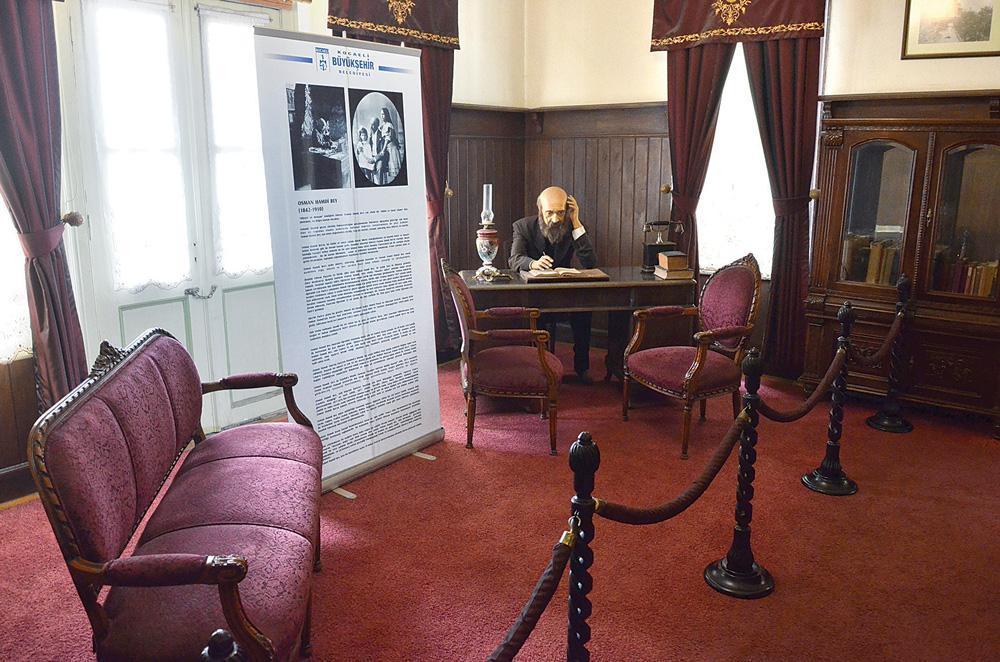
The memory of Osman Hamdi Bey, known as the first representative of figurative painting in the late Ottoman Empire and the painter of the famous “The Tortoise Trainer,” is being kept alive in a summer house in the northwestern province of Gebze.
The summer house of Osman Hamdi located in the Eskihisar district, receives around 50,000 visitors every year.
The museum house has a painting atelier and a boathouse in its garden. It draws interest mainly from archaeology, architecture and history of art researchers and students.
Operated by the Kocaeli Metropolitan Municipality since 2007 and open seven days a week for free, the house displays a number of original objects owned by Osman Hamdi and displays reproductions of some of his paintings and beeswax sculptures. Colorful flower figures made by Osman Hamdi feature on the doors of rooms on the entrance floor.
Among the most important parts of the museum, the boat house and the painting atelier, which have been restored, also draw attention for their original architectural style.
Osman Hamdi was born in 1842 in Istanbul and his father was one of the top officials at the time, Grand Vizier Ethem Paşa. He played a significant role in the modernization and transformation process of the Ottoman Empire in the 19th century and is known as a pioneer of painting in Turkey.
“Osman Hamdi was also very famous in the field of museum management in Europe. As a painter he produced many works depicting places in Ottoman society. They almost serve as historical documents. A top official in Europe, the Austro-Hungarian Emperor Franz Joseph, bought one of his paintings,” said Professor Fatma Ürekli, the head of Mimar Sinan Fine Arts University’s History Department.
“The demands of Osman Hamdi, who was the director of Imperial Museum and the School of Fine Arts in the era of Sultan Abdulhamid II, were not rejected as much as possible because he was determined, hardworking, honest and decisive. He did not get involved in political affairs other than his own missions,” Ürekli added.
“He spent the summer months with his family in Eskihisar and produced some of his most important paintings here. He also has paintings depicting the history of Eskihisar and its historic artifacts. He painted the historical structures and scenes here as the atmosphere was very good for him. It is known that the whole family gathered here in the cherry season. He moved to his house after 1890s. He brought the materials of that home from abroad and planted colorful flowers and trees in its garden,” she said.
Osman Hamdi died on Feb. 24, 1901 in his mansion in the Bosphorus neighborhood of Kuruçeşme and was buried in Eskihisar, in line with his will.
“The house in Eskihisar was not used for some time and was registered in 1966. It was expropriated in 1982 and underwent a comprehensive restoration project between 1985 and 1987. Then it was opened to visitors as a museum. There are very few original belongings of Osman Hamdi but the painting atelier that he used in summer is here. It serves as a gallery today. Three months after he died, two Seljuk tomb stones in the garden of the Istanbul Archaeology Museums were placed in his tomb with a cabinet decision. There is also a sign about Osman Hamdi at the entrance of the Istanbul Archaeology Museum,” Ürekli said.
The School of Fine Arts, of which he was the director, led arts education in the Ottoman Empire for many years.
“The test documents of people who will serve as teachers in different parts of the country were sent to the school. A commission led by Osman Hamdi evaluated the documents. He could be very harsh in his evaluations but he was in love with his mission,” Ürekli noted.